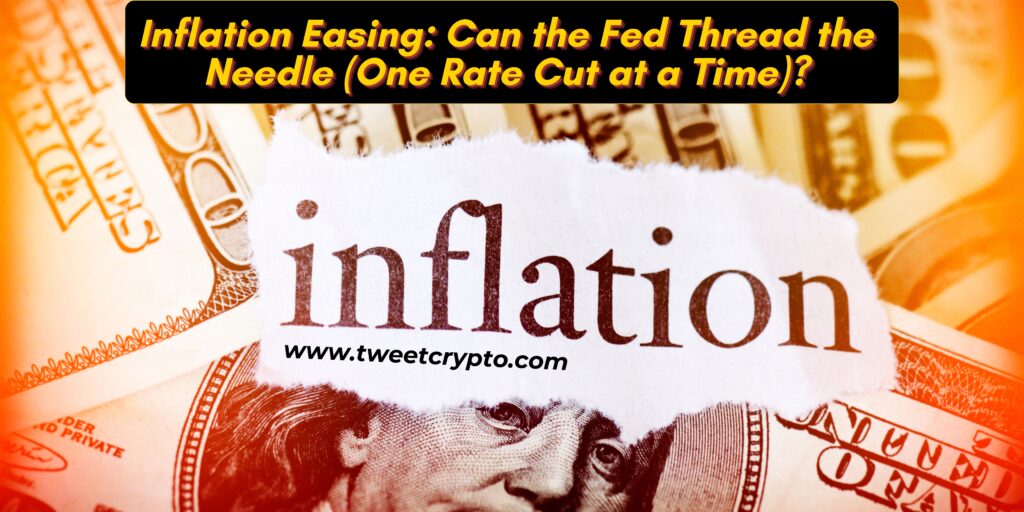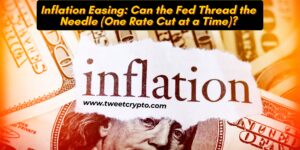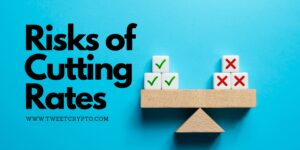Inflation Easing: Can the Fed Thread the Needle (1 Rate Cut at a Time)?

- Introduction
- Inflation: The Silent Thief
- The Federal Reserve’s Role
- The Concept of a Soft Landing
- Understanding Inflation
- What is Inflation?
- Causes of Inflation
- The Impact of Inflation on the Economy
- The Federal Reserve’s Strategy
- Role of the Federal Reserve
- Interest Rates Explained
- Historical Context of Rate Cuts
- The Concept of a Soft Landing
- What is a Soft Landing?
- Why It’s Crucial for the Economy
- Previous Attempts and Outcomes
- The Mechanics of a Rate Cut
- How Rate Cuts Work
- Immediate Effects on Borrowing and Spending
- Long-term Economic Implications
- Risks of Cutting Rates
- The Danger of Cutting Too Much
- The Risk of Cutting Too Little
- External Factors and Uncertainties
- Global Economic Factors
- The Impact of Global Events
- Supply Chain Disruptions
- Geopolitical Tensions
- Crypto and Inflation
- How Inflation Affects Cryptocurrencies
- The Relationship Between Interest Rates and Crypto
- Potential Benefits for Crypto Investors
- The Fed’s Delicate Balancing Act
- Weighing Economic Data
- Managing Market Expectations
- Communicating Policies Effectively
- Market Reactions and Predictions
- How Markets Typically React to Rate Cuts
- Current Market Sentiment
- Predictions for the Future
- Case Studies of Past Rate Cuts
- Successful Soft Landings
- When Things Went Wrong
- Lessons Learned
- Expert Opinions
- Views from Economists
- Insights from Financial Analysts
- Perspectives from Crypto Experts
- What to Watch For
- Key Economic Indicators
- Fed Announcements and Meetings
- Market Signals
- Strategies for Investors
- Diversifying Investments
- Staying Informed
- Adapting to Changing Economic Conditions
- Conclusion
- Recap of Key Points
- The Importance of Vigilance
- Final Thoughts on the Fed’s Challenge
- FAQs
- What is a soft landing in economic terms?
- How do interest rates affect inflation?
- Why is the Fed considering a rate cut now?
- How can investors protect their assets during economic uncertainty?
- What are the potential long-term effects of the Fed’s rate cuts?
You may also like :
Inflation Easing: Can the Fed Thread the Needle (One Rate Cut at a Time)?

Inflation: The Silent Thief
Buckle up, crypto fam! Let’s talk about the elephant in the room: inflation. Remember those days when your favorite memecoin mysteriously lost value overnight? Yeah, that was inflation at work, eroding purchasing power like a rogue Satoshi disappearing into the blockchain abyss. But here’s the good news: inflation seems to be cooling down. Imagine Bitcoin finally finding support after a wild rollercoaster ride.
The Federal Reserve’s Role
The Federal Reserve, the central bank of the US, is taking notice. They’re thinking about easing up on interest rates – basically, the price of borrowing money. This could be a game-changer, but there’s a catch… the Fed needs to thread the needle and achieve a soft landing.
The Concept of a Soft Landing
Think of a soft landing like landing a spaceship on the moon. Nailing it requires precision. In this case, the Fed wants to slow down inflation without crashing the entire economy (think recession – that’s when things get real ugly).
Understanding Inflation
What is Inflation?
Inflation is the rate at which the general level of prices for goods and services rises, eroding purchasing power. It’s like that slow leak in a tire – it doesn’t seem like a big deal until your ride becomes bumpy and uncomfortable.
Causes of Inflation
Inflation can be caused by various factors, including increased demand for products and services, rising production costs, and expansionary monetary policies. It’s like too many people chasing too few goods.
The Impact of Inflation on the Economy
Inflation affects everything from the cost of groceries to mortgage rates. High inflation can reduce the value of money, increase the cost of living, and create uncertainty in the economy.
The Federal Reserve’s Strategy
Role of the Federal Reserve
The Federal Reserve, or the Fed, is responsible for regulating the US monetary system. Their goal is to maintain stable prices and full employment. They use tools like interest rates to influence economic activity.
Interest Rates Explained
Interest rates are the cost of borrowing money. When the Fed lowers rates, borrowing becomes cheaper, encouraging spending and investment. Higher rates do the opposite, curbing spending to cool down the economy.
Historical Context of Rate Cuts
Historically, the Fed has used rate cuts to respond to economic downturns. For instance, during the 2008 financial crisis, the Fed slashed rates to near zero to stimulate growth.
The Concept of a Soft Landing
What is a Soft Landing?
A soft landing refers to the Fed’s goal of slowing down inflation without triggering a recession. It’s like carefully easing off the gas pedal to avoid skidding off the road.
Why It’s Crucial for the Economy
Achieving a soft landing is crucial because it can stabilize prices and maintain employment levels, avoiding the economic pain of a recession.
Previous Attempts and Outcomes
The Fed has attempted soft landings in the past with varying degrees of success. In the mid-1990s, they managed to slow down the economy without causing a recession, a textbook example of a soft landing.
The Mechanics of a Rate Cut
How Rate Cuts Work
When the Fed cuts rates, it lowers the cost of borrowing. This can stimulate spending by businesses and consumers, boosting economic activity.
Immediate Effects on Borrowing and Spending
Lower rates make loans and mortgages cheaper, encouraging people to borrow and spend more. This increased spending can help drive economic growth.
Long-term Economic Implications
Over the long term, rate cuts can lead to increased investment, higher employment, and overall economic expansion. However, they can also risk reigniting inflation if not managed carefully.
Risks of Cutting Rates

The Danger of Cutting Too Much
Cutting rates too much can lead to runaway inflation, where prices rise uncontrollably, eroding purchasing power.
The Risk of Cutting Too Little
Conversely, cutting too little can result in a stalled economy, where growth slows, and unemployment rises.
External Factors and Uncertainties
Global events, such as geopolitical tensions and supply chain disruptions, can also impact the effectiveness of rate cuts, adding to the uncertainty.
Global Economic Factors
The Impact of Global Events
Global events, like wars or trade disputes, can affect inflation and economic stability, making it harder for the Fed to control the economy.
Supply Chain Disruptions
Disruptions in the supply chain can lead to shortages and higher prices, complicating the Fed’s efforts to manage inflation.
Geopolitical Tensions
Tensions between countries can impact trade and economic stability, influencing inflation and economic growth.
Crypto and Inflation
How Inflation Affects Cryptocurrencies
Inflation can reduce the value of fiat currencies, making cryptocurrencies an attractive alternative. However, high inflation can also lead to increased volatility in crypto markets.
The Relationship Between Interest Rates and Crypto
Generally, rising interest rates tend to push crypto prices down as investors seek safer, interest-bearing assets. Conversely, lower rates can boost crypto prices as investors search for higher returns.
Potential Benefits for Crypto Investors
A successful soft landing could stabilize the economy, potentially benefiting riskier assets like cryptocurrencies as investor confidence returns.
The Fed’s Delicate Balancing Act
Weighing Economic Data
The Fed relies on economic data, such as employment rates and inflation figures, to make informed decisions about rate cuts.
Managing Market Expectations
Communicating policies effectively is crucial. The Fed needs to manage market expectations to avoid causing panic or confusion.
Communicating Policies Effectively
Clear and transparent communication helps the Fed maintain credibility and guide market behavior, reducing uncertainty.
Market Reactions and Predictions

How Markets Typically React to Rate Cuts
Markets often react positively to rate cuts, seeing them as a sign of economic support. However, the reaction can vary based on the context and expectations.
Current Market Sentiment
Currently, markets are cautiously optimistic but remain wary of potential economic slowdowns and external shocks.
Predictions for the Future
Experts predict a cautious approach from the Fed, with potential for gradual rate cuts if inflation continues to ease without significant economic downturns.
Case Studies of Past Rate Cuts
Successful Soft Landings
In the mid-1990s, the Fed managed to slow down the economy without causing a recession, a prime example of a successful soft landing.
When Things Went Wrong
During the 1970s, the Fed struggled with stagflation – a combination of high inflation and unemployment – highlighting the challenges of managing economic policy.
Lessons Learned
Past experiences show the importance of flexibility, data-driven decisions, and clear communication in achieving economic stability.
Expert Opinions
Views from Economists
Economists generally agree that a cautious approach is necessary, balancing the need to control inflation with supporting economic growth.
Insights from Financial Analysts
Financial analysts emphasize the importance of monitoring market reactions and adjusting policies as needed to maintain stability.
Perspectives from Crypto Experts
Crypto experts highlight the potential for cryptocurrencies to benefit from economic uncertainty, offering an alternative to traditional assets.
What to Watch For
Key Economic Indicators
Watch for changes in inflation rates, employment figures, and consumer spending as indicators of economic health.
Fed Announcements and Meetings
Pay attention to Fed announcements and meetings for insights into their policy decisions and economic outlook.
Market Signals
Market reactions to economic data and Fed announcements can provide clues about future economic trends and investment opportunities.
Strategies for Investors
Diversifying Investments
Diversifying investments can help manage risk and take advantage of different market conditions.
Staying Informed
Staying informed about economic trends and Fed policies can help investors make better decisions.
Adapting to Changing Economic Conditions
Being flexible and ready to adapt strategies as economic conditions change is crucial for long-term success.
Conclusion
The Fed’s next move is a hot topic. A single rate cut might be the first step towards a soft landing, but it’s no sure thing. Crypto holders should stay informed and adapt their strategies as the situation unfolds. Remember, the crypto world thrives on innovation and adaptability – just like the Fed needs to be right now. Stay tuned, and let’s see if they can thread the needle!
FAQs
What is a soft landing in economic terms?
A soft landing refers to the Fed’s attempt to slow down inflation without triggering a recession, aiming for a stable and balanced economy.
How do interest rates affect inflation?
Interest rates influence borrowing and spending. Lower rates encourage spending, potentially boosting inflation, while higher rates can cool down the economy and reduce inflation.
Why is the Fed considering a rate cut now?
The Fed is considering a rate cut to stimulate economic growth and control inflation, aiming for a balanced economic environment.
How can investors protect their assets during economic uncertainty?
Investors can protect their assets by diversifying investments, staying informed about economic trends, and being ready to adapt their strategies.
What are the potential long-term effects of the Fed’s rate cuts?
Long-term effects of rate cuts can include increased economic growth and investment, but there is also a risk of reigniting inflation if not managed carefully.








 Bitcoin
Bitcoin  Ethereum
Ethereum  Tether
Tether  XRP
XRP  Solana
Solana  USDC
USDC  Cardano
Cardano  Dogecoin
Dogecoin  TRON
TRON  Lido Staked Ether
Lido Staked Ether  Pi Network
Pi Network  Wrapped Bitcoin
Wrapped Bitcoin  LEO Token
LEO Token  Hedera
Hedera  USDS
USDS  Chainlink
Chainlink  Wrapped stETH
Wrapped stETH  Stellar
Stellar  Avalanche
Avalanche  Shiba Inu
Shiba Inu  Sui
Sui  Litecoin
Litecoin  Bitcoin Cash
Bitcoin Cash  Toncoin
Toncoin  MANTRA
MANTRA  Polkadot
Polkadot  Lombard Staked BTC
Lombard Staked BTC  Ethena USDe
Ethena USDe  WETH
WETH  Binance Bridged USDT (BNB Smart Chain)
Binance Bridged USDT (BNB Smart Chain)  Bitget Token
Bitget Token  Hyperliquid
Hyperliquid  WhiteBIT Coin
WhiteBIT Coin  Wrapped eETH
Wrapped eETH  Monero
Monero  Uniswap
Uniswap  sUSDS
sUSDS  Dai
Dai  Aptos
Aptos  NEAR Protocol
NEAR Protocol  Ondo
Ondo  Ethereum Classic
Ethereum Classic  Pepe
Pepe  Aave
Aave  Internet Computer
Internet Computer  OKB
OKB  Coinbase Wrapped BTC
Coinbase Wrapped BTC  Gate
Gate  Mantle
Mantle